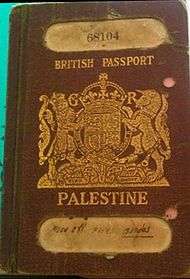Mandatory Palestine passport
| Mandatory Palestine passport | |
|---|---|
 The front cover of a Mandatory Palestine passport. | |
| Issued by |
|
| Type of document | Passport |
| Purpose | Identification |
The Mandatory Palestine passport refers to the travel document that was intended for residents of Mandatory Palestine between 1925 and 1948. The first brown-covered passport appeared around 1927, following the Nationality Law from 1925. From 1926 to 1935 alone approximately 70,000 of such travel documents were granted.[1]

The status of Palestinian citizenship was not legally defined until 1925. Before that time, the Government of Palestine issued British passports to those with British nationality, and two types of travel document to others:
- A Provisional Certificate of Palestinian Nationality was available to persons who had indicated their intention to become Palestinian citizens and live in Palestine, provided they were born in Palestine, their father was born in Palestine, or they were an "ex-Russian subject who compulsorily acquired Ottoman nationality in Palestine during the recent war".[2] The wives such people were also eligible from late 1924.[3]
- An emergency Laissez-passer.[2]
Palestinian citizenship and the various means of obtaining it was defined in an Order in Council of 24 July 1925.[4] Turkish subjects habitually resident in Palestine (excluding Transjordan) on the first day of August 1925 automatically became citizens unless they opted to reject it.[4] Many other classes of people were able to apply for citizenship, which would be granted at the discretion of the High Commissioner.[4] An ordinance allowing the High Commissioner to issue passports to Palestinian citizens was promulgated soon afterwards.[5]
Although the nature of Palestinian citizenship had been debated within the British government since 1920, the main reason it was delayed was that Turkish citizens were officially enemy aliens until the Treaty of Lausanne was ratified in 1923.[6]
These passports became invalid with the termination of the British mandate on 15 May 1948.[7] Even so, in the early 1950s, United Nations officials described the "worn dog-eared Palestine passport issued in Mandate days by a government that no longer legally exists" as "mementos of identity that were treasured by refugees".[8]
Israeli and Jordanian passports were offered to former British Mandate subjects according to the citizenship they acquired in the aftermath of the 1948 Arab-Israeli War. A significant number of Palestinian people, especially in the Gaza Strip and those who found refuge in Syria and Lebanon, remained stateless.
See also
Sources
References
- ↑ Qafisheh, Mutaz M (2008). The international law foundations of Palestinian nationality: a legal examination of nationality in Palestine under Britain's rule. Graduate Institute of International Studies. 7. BRILL. p. 149. ISBN 978-90-04-16984-5.
- 1 2 Official Gazette of the Government of Palestine, No. 116, 1 June 1924, pp. 690–692.
- ↑ Official Gazette of the Government of Palestine, No. 127, 15 November 1924, pp. 908–909.
- 1 2 3 Official Gazette of the Government of Palestine, No. 147, 16 September 1925, pp. 460–466.
- ↑ Text: Official Gazette of the Government of Palestine, No. 153, 16 November 1924, pp. 564–566. Promulgation: Official Gazette of the Government of Palestine, No. 151, 16 December 1924, p. 626.
- ↑ Lauren E. Banko (2011). "The Legislative Creation of Palestinian Citizenship: Discourses in the Early Mandate Period". International Journal For Arab Studies. 2 (2): 1–32.
- ↑ Artz, 1997 p. 77.
- ↑ Feldman, Hana (2008). "Refusing Invisibility: Documentation and Memorialization in Palestinian Refugee Claims". Journal of Refugee Studies. Oxford University Press. 21 (4): 498–516. doi:10.1093/jrs/fen044. ISSN 1471-6925. Retrieved 2011-01-23.